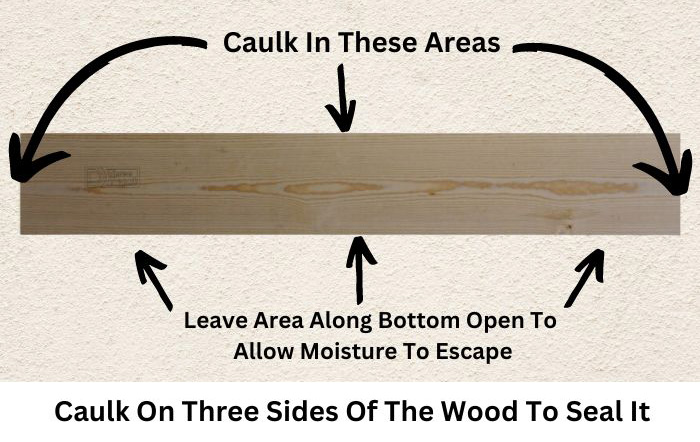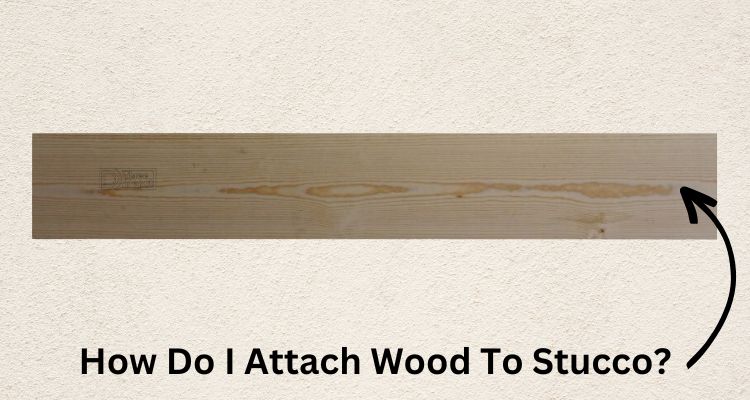
You might be wondering how you would go about attaching wood to a stucco wall, which is a totally different material and you want to make sure that you don't cause any problems down the road, too...right?
This article will go into detail about how you should attach any type of wood to just about any stucco system out there and make sure that it is strong and weather tight, in the process. Let's dive in!
What Strength Is Needed?
The first thing that should be talked about is the strength that is needed when you are planning on attaching a piece of wood to a stucco wall. There will be different requirements for different situations, and this really boils down to how much weight or force will be applied to that piece of wood.
For example, a small wooden decorative shelf that weighs 3 pounds will not need the amount of strength that a pergola support or ledger board for a deck will need.
This will basically tell us what type of fasteners we can use and whether we need to look for a load bearing area of the wall to attach to (wall studs, rim joist, etc.).
Where you attach the wood on the wall also affects strength. Attaching the wood to the studs in the wall is a far superior anchoring point, compared to attaching in between the studs, relying on the stucco and/or shear behind the stucco.
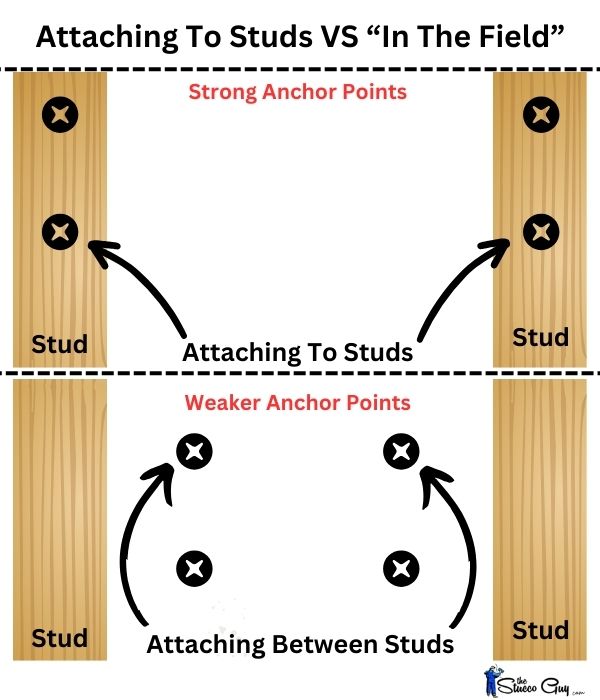
What Kind of Stucco System Do You Have?
Another important consideration you need to take into account is what type of stucco system you have on your home, as they each have differences that could affect your method of attachment.
3 Coat Stucco: The three coat stucco system is probably the best system to have on your walls when it comes to attaching anything wood. You could mount to a stud, like any other stucco system, but it can also accommodate a moderate amount of weight if it is just screwed into the stucco, between the studs, due to the total thickness being around 1".
If your walls have plywood or OSB attached to the framing, then it will be able to hold even more weight when attaching between the studs. The fasteners (if used) should be at least 2" long if you have an open stud wall design and a minimum of 2 1/2" if you have shear walls (plywood or OSB), plus the width of the wood.
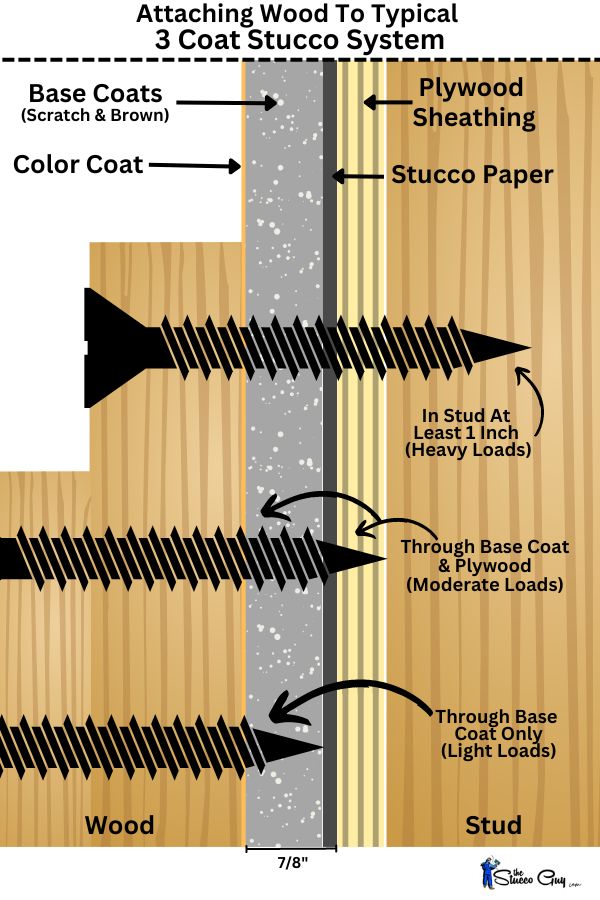
1 Coat Stucco: A one coat stucco system uses 1" foam and then 3/8" of a base coat of cement and a bit more when a finish is applied. If you have a one coat stucco system, then I would only mount very light items where there is not any framing backing to attach to.
You could attach to the studs on the wall though and get a secure connection, just make sure you are using fasteners that are at least 2 1/2" for open stud walls and 3" for walls that have shear installed, plus the width of the wood.
I do want to mention that if you decide to find the studs on the wall and attach to these, you will want to keep in mind that you will likely crush the foam a bit when torquing a fastener down, as the foam is quite soft and there really is not much in the way of cement to add any significant reinforcement.
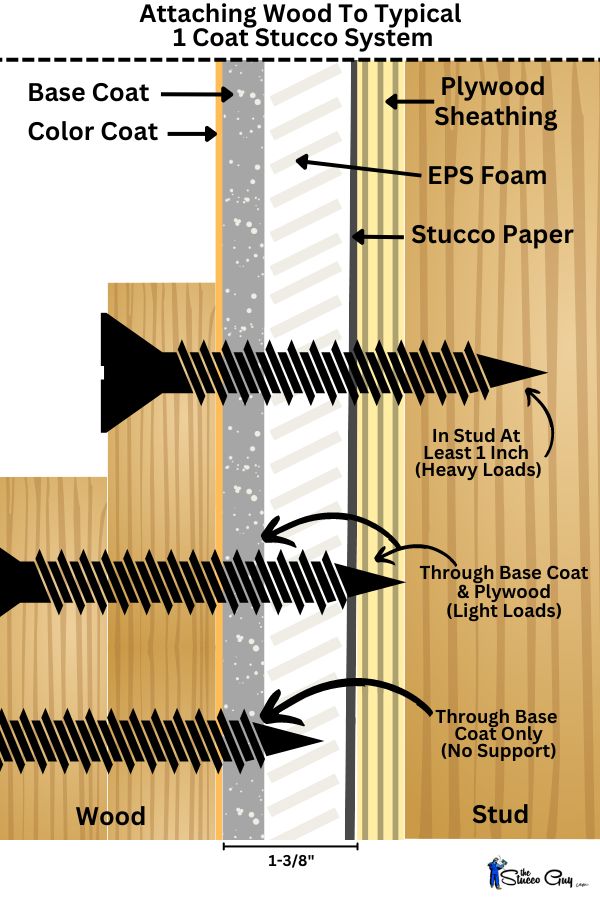
EIFS Stucco: EIFS is similar to one coat stucco, that is, when attaching wooden items to the walls with the added negative effect of causing potential leaking issues in the wall if anything penetrates the wall. EIFS is designed this way and is less forgiving than the other two systems when penetrations are made.
Shear Walls VS Open Stud Walls...
One other minor detail to consider is whether your walls have plywood or OSB attached to the studs, or if you have an open stud type of layout on your walls. This won't affect much if you are attaching to studs on the wall, but can cause a bit of a problem when you try to attach something in the middle of the studs.
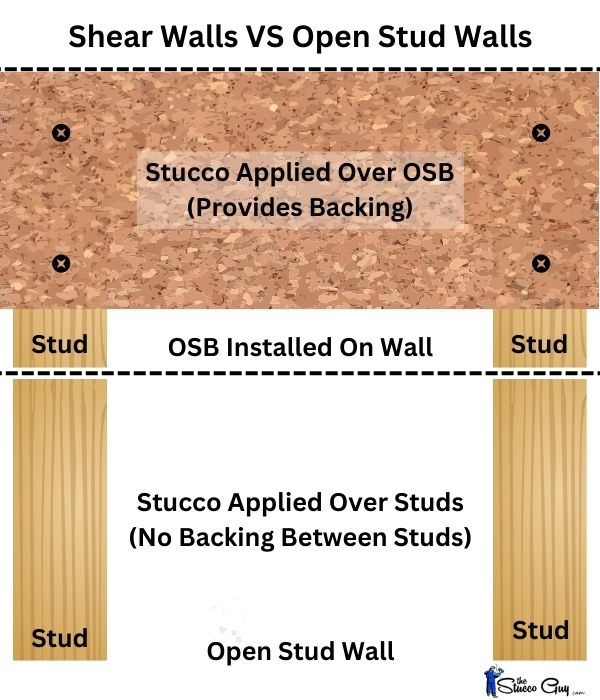
Shear Walls: The plywood or OSB (or other backing material) will provide additional support in areas where there are no studs or other framing backing.
These range in thickness and are typically around 1/2" - 5/8" for newer buildings, but I have seen 3/4" - 1+" used as backing on much older buildings, usually in the form of horizontal boards that were some sort of rough sawn material.
Open Stud Walls: An open stud system uses no shear behind the stucco itself, it is, as the name implies, just the open studs. If there is no shear behind the stucco and you want to fasten in between the studs, then I would only recommend using a light to moderate weighted item, for a three coat system and light items for one coat stucco systems.
Methods of Attaching Wood To Stucco...
There are only four real ways to attach wood to stucco and these are: screwing into the stucco, nailing into it, using anchors or using some sort of adhesive. These are your options, for the most part, but each has their advantages and disadvantages.
Screwing Into The Stucco: Screwing into the stucco is probably one of the best ways to attach wood to stucco walls because it grabs either the stucco or any wood underneath. They make specialty screws for this, which makes it much more convenient, but regular exterior screws can also be used. Just make sure your length is long enough to attach the wood to the wall!
You will need a drill, in order to do this, though, first for predrilling a pilot hole and then for fastening the screw into the stucco itself. After you drill your hole, blow out any dust and fill the hole with caulking, and then drive the screw into the wall.
You will want to be sure that you do not over tighten the screw using the drill, as it could strip the threads and render that hole useless for another screw of the same size.
Nailing Into The Stucco: You can also nail into the stucco, but I will forewarn you that this will create shock in the wall itself, which can cause cracking if you are too aggressive. Of course, this will only work if you have some sort of backing behind the stucco itself, as you would want to drive the nail into a stud or some other framing backing.
Like with screwing into stucco, I would recommend predrilling first, all the way through the stucco, blow out the dust, fill the hole with caulking and then drive the nail into the wall, GENTLY.
Using An Anchor: You also have the option of using a wall anchor, like you would with drywall. You will want to use a metal version, though, preferably with some type of rust protection.
You will also need to drill into the stucco, in order to screw the anchor into the stucco itself. These are usually used in between studs, where there is no wood backing (studs).
If you are planning on screwing, nailing or using an anchor to attach the wood to the wall, I would recommend adding some caulking (polyurethane or silicone caulks work good) down the pilot hole to provide a waterproof seal.
Using An Adhesive: The last way you can attach wood to stucco would be to use an adhesive of some sort. I would recommend stronger adhesives like PL subfloor glue (polyurethane adhesive) or something more people are familiar with like Liquid Nails. Here are a few good examples.
If you are planning on using an adhesive, the stucco should be cleaned, along with the side of the wood that will be attached to the wall. You will also need to try to prop the wood in place with a moderate amount of pressure, giving the adhesive time to set up. This can take several hours to achieve, so plan ahead!
An adhesive can be used anywhere on the wall and can support light to moderate loads. One downside to using an adhesive is that it may leave a hard to remove residue if/when the item is removed from the wall.
Adhesives can also include double-sided tape and other products that use some sort of adhesive that sticks to the wall.
Sealing The Wood To The Stucco Wall:
Once you have the wood attached to the wall, it would be a good idea to seal around it, to prevent any water from getting in, but also allowing any water that might be trapped to escape. This will provide an additional barrier, on top of the caulking you put in the pilot holes you drilled.
I like to seal three sides and those are usually the top and sides and I usually leave the bottom open to allow any trapped water to escape, when and if that situation arises. Remember, the stucco and wood could absorb water, so you want to allow air to circulate behind the two materials.
